IKEA: Leadership, Management Roles and Operational Strategies
VerifiedAdded on 2020/10/22
|13
|4099
|477
Report
AI Summary
This report provides a comprehensive analysis of leadership and management practices within IKEA, examining the distinct roles and characteristics of leaders and managers. It explores their functions in various situational contexts, particularly focusing on technical changes and staff turnover. The report delves into different leadership theories and models, including situational leadership, systems leadership, and contingency theory, and discusses their application within IKEA. It also investigates the approaches of leaders and managers in improving operational management to achieve business objectives and identifies factors impacting operational management and decision-making. The report highlights the importance of effective leadership and management in fostering a productive work environment and achieving organizational success, using IKEA as a case study to illustrate these concepts.
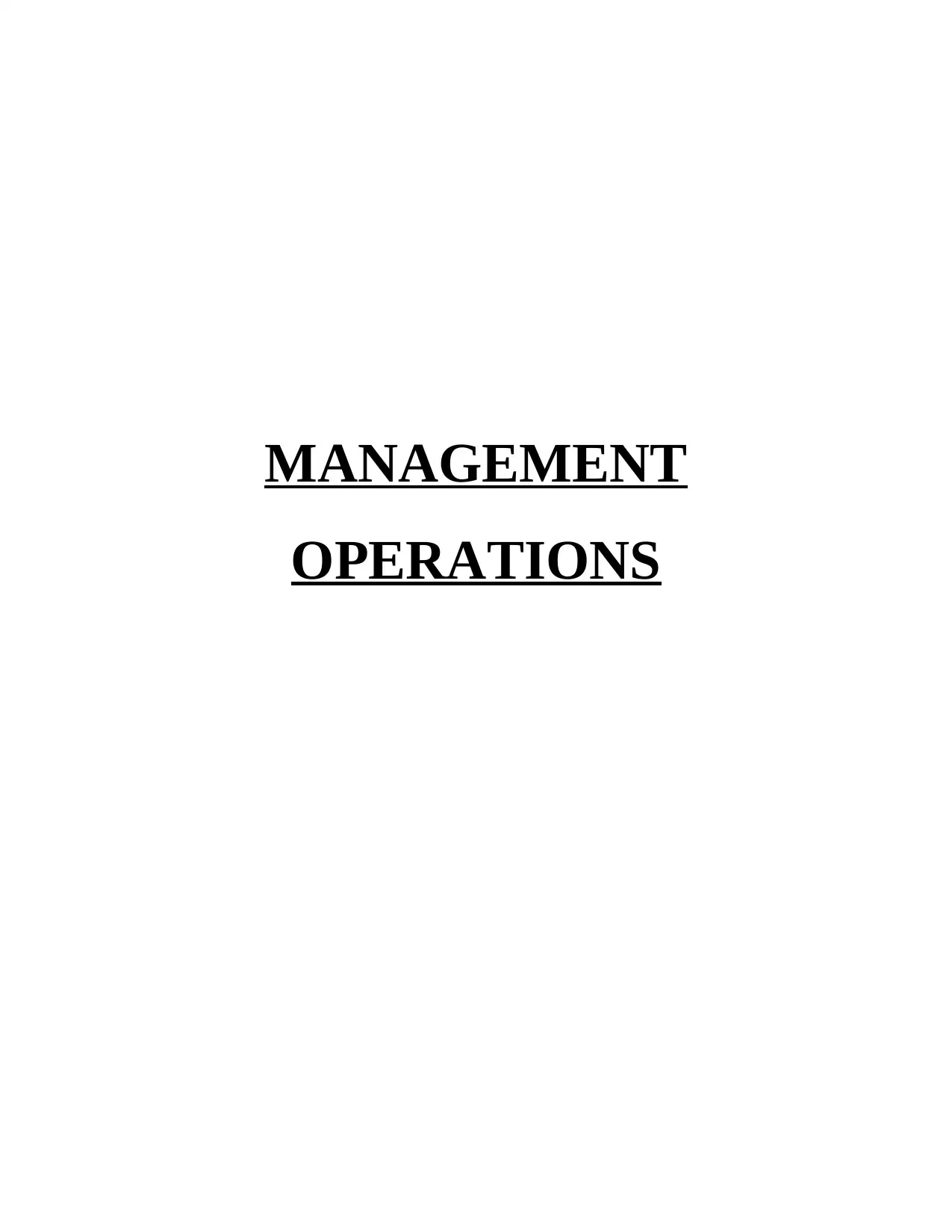
MANAGEMENT
OPERATIONS
OPERATIONS
Paraphrase This Document
Need a fresh take? Get an instant paraphrase of this document with our AI Paraphraser
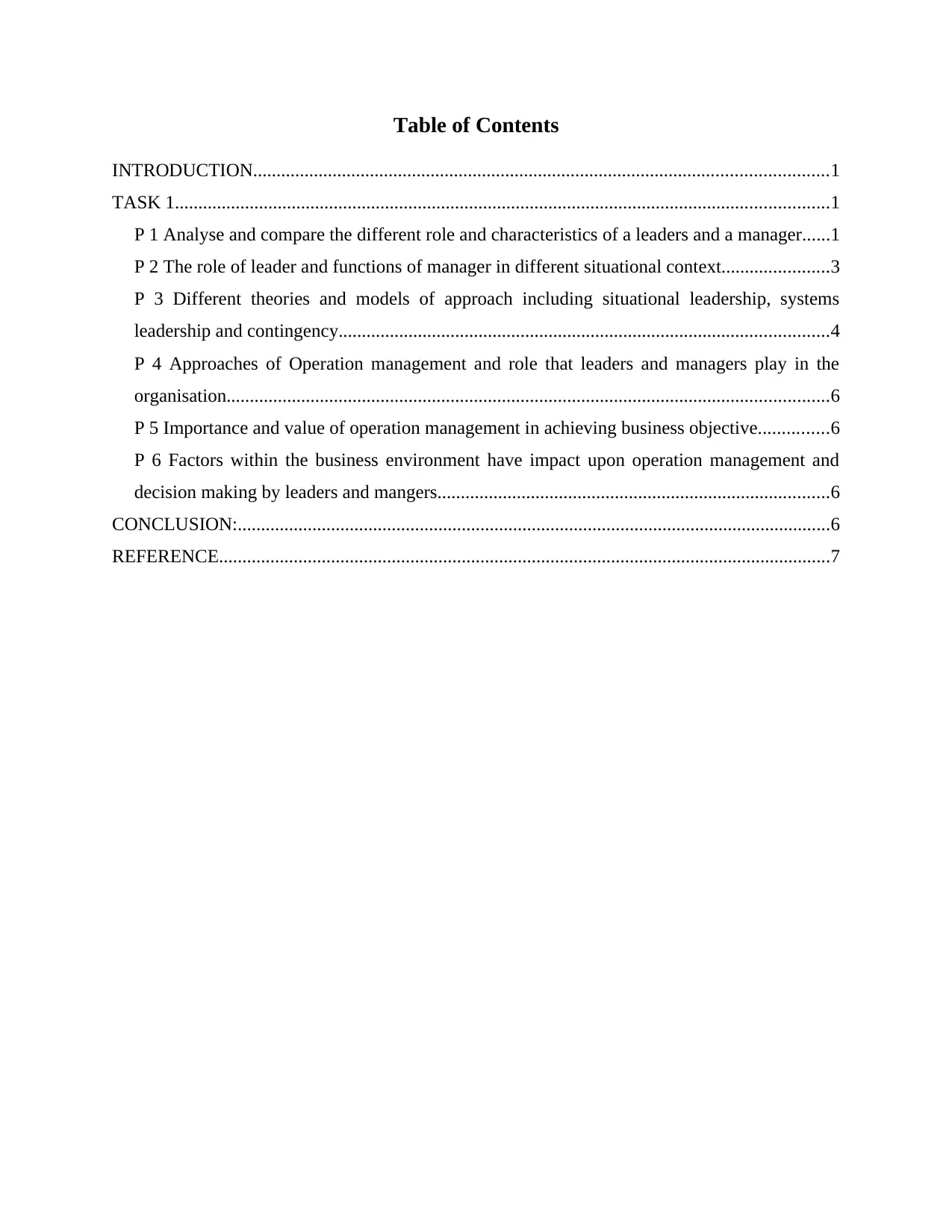
Table of Contents
INTRODUCTION...........................................................................................................................1
TASK 1............................................................................................................................................1
P 1 Analyse and compare the different role and characteristics of a leaders and a manager......1
P 2 The role of leader and functions of manager in different situational context.......................3
P 3 Different theories and models of approach including situational leadership, systems
leadership and contingency.........................................................................................................4
P 4 Approaches of Operation management and role that leaders and managers play in the
organisation.................................................................................................................................6
P 5 Importance and value of operation management in achieving business objective...............6
P 6 Factors within the business environment have impact upon operation management and
decision making by leaders and mangers....................................................................................6
CONCLUSION:...............................................................................................................................6
REFERENCE...................................................................................................................................7
INTRODUCTION...........................................................................................................................1
TASK 1............................................................................................................................................1
P 1 Analyse and compare the different role and characteristics of a leaders and a manager......1
P 2 The role of leader and functions of manager in different situational context.......................3
P 3 Different theories and models of approach including situational leadership, systems
leadership and contingency.........................................................................................................4
P 4 Approaches of Operation management and role that leaders and managers play in the
organisation.................................................................................................................................6
P 5 Importance and value of operation management in achieving business objective...............6
P 6 Factors within the business environment have impact upon operation management and
decision making by leaders and mangers....................................................................................6
CONCLUSION:...............................................................................................................................6
REFERENCE...................................................................................................................................7
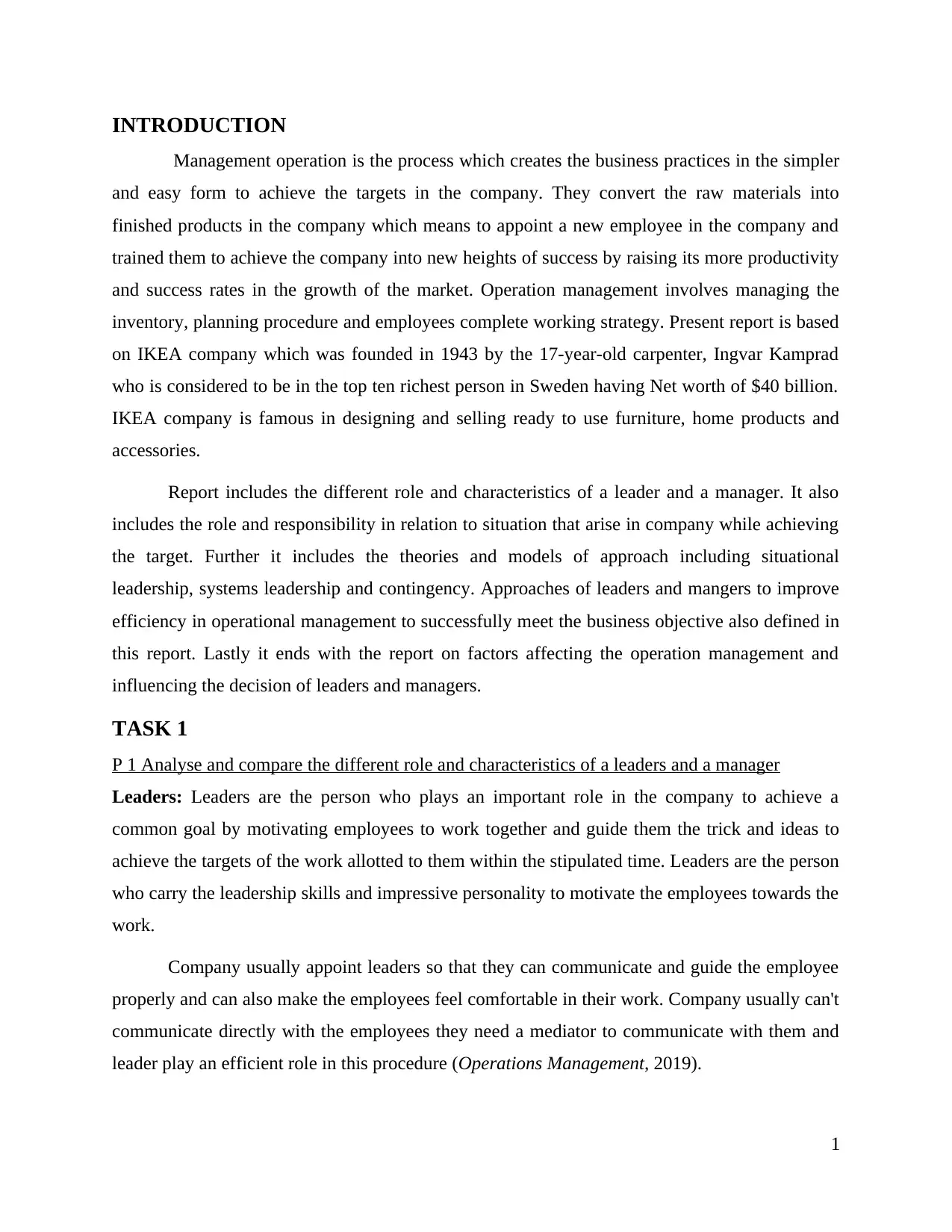
INTRODUCTION
Management operation is the process which creates the business practices in the simpler
and easy form to achieve the targets in the company. They convert the raw materials into
finished products in the company which means to appoint a new employee in the company and
trained them to achieve the company into new heights of success by raising its more productivity
and success rates in the growth of the market. Operation management involves managing the
inventory, planning procedure and employees complete working strategy. Present report is based
on IKEA company which was founded in 1943 by the 17-year-old carpenter, Ingvar Kamprad
who is considered to be in the top ten richest person in Sweden having Net worth of $40 billion.
IKEA company is famous in designing and selling ready to use furniture, home products and
accessories.
Report includes the different role and characteristics of a leader and a manager. It also
includes the role and responsibility in relation to situation that arise in company while achieving
the target. Further it includes the theories and models of approach including situational
leadership, systems leadership and contingency. Approaches of leaders and mangers to improve
efficiency in operational management to successfully meet the business objective also defined in
this report. Lastly it ends with the report on factors affecting the operation management and
influencing the decision of leaders and managers.
TASK 1
P 1 Analyse and compare the different role and characteristics of a leaders and a manager
Leaders: Leaders are the person who plays an important role in the company to achieve a
common goal by motivating employees to work together and guide them the trick and ideas to
achieve the targets of the work allotted to them within the stipulated time. Leaders are the person
who carry the leadership skills and impressive personality to motivate the employees towards the
work.
Company usually appoint leaders so that they can communicate and guide the employee
properly and can also make the employees feel comfortable in their work. Company usually can't
communicate directly with the employees they need a mediator to communicate with them and
leader play an efficient role in this procedure (Operations Management, 2019).
1
Management operation is the process which creates the business practices in the simpler
and easy form to achieve the targets in the company. They convert the raw materials into
finished products in the company which means to appoint a new employee in the company and
trained them to achieve the company into new heights of success by raising its more productivity
and success rates in the growth of the market. Operation management involves managing the
inventory, planning procedure and employees complete working strategy. Present report is based
on IKEA company which was founded in 1943 by the 17-year-old carpenter, Ingvar Kamprad
who is considered to be in the top ten richest person in Sweden having Net worth of $40 billion.
IKEA company is famous in designing and selling ready to use furniture, home products and
accessories.
Report includes the different role and characteristics of a leader and a manager. It also
includes the role and responsibility in relation to situation that arise in company while achieving
the target. Further it includes the theories and models of approach including situational
leadership, systems leadership and contingency. Approaches of leaders and mangers to improve
efficiency in operational management to successfully meet the business objective also defined in
this report. Lastly it ends with the report on factors affecting the operation management and
influencing the decision of leaders and managers.
TASK 1
P 1 Analyse and compare the different role and characteristics of a leaders and a manager
Leaders: Leaders are the person who plays an important role in the company to achieve a
common goal by motivating employees to work together and guide them the trick and ideas to
achieve the targets of the work allotted to them within the stipulated time. Leaders are the person
who carry the leadership skills and impressive personality to motivate the employees towards the
work.
Company usually appoint leaders so that they can communicate and guide the employee
properly and can also make the employees feel comfortable in their work. Company usually can't
communicate directly with the employees they need a mediator to communicate with them and
leader play an efficient role in this procedure (Operations Management, 2019).
1
⊘ This is a preview!⊘
Do you want full access?
Subscribe today to unlock all pages.

Trusted by 1+ million students worldwide
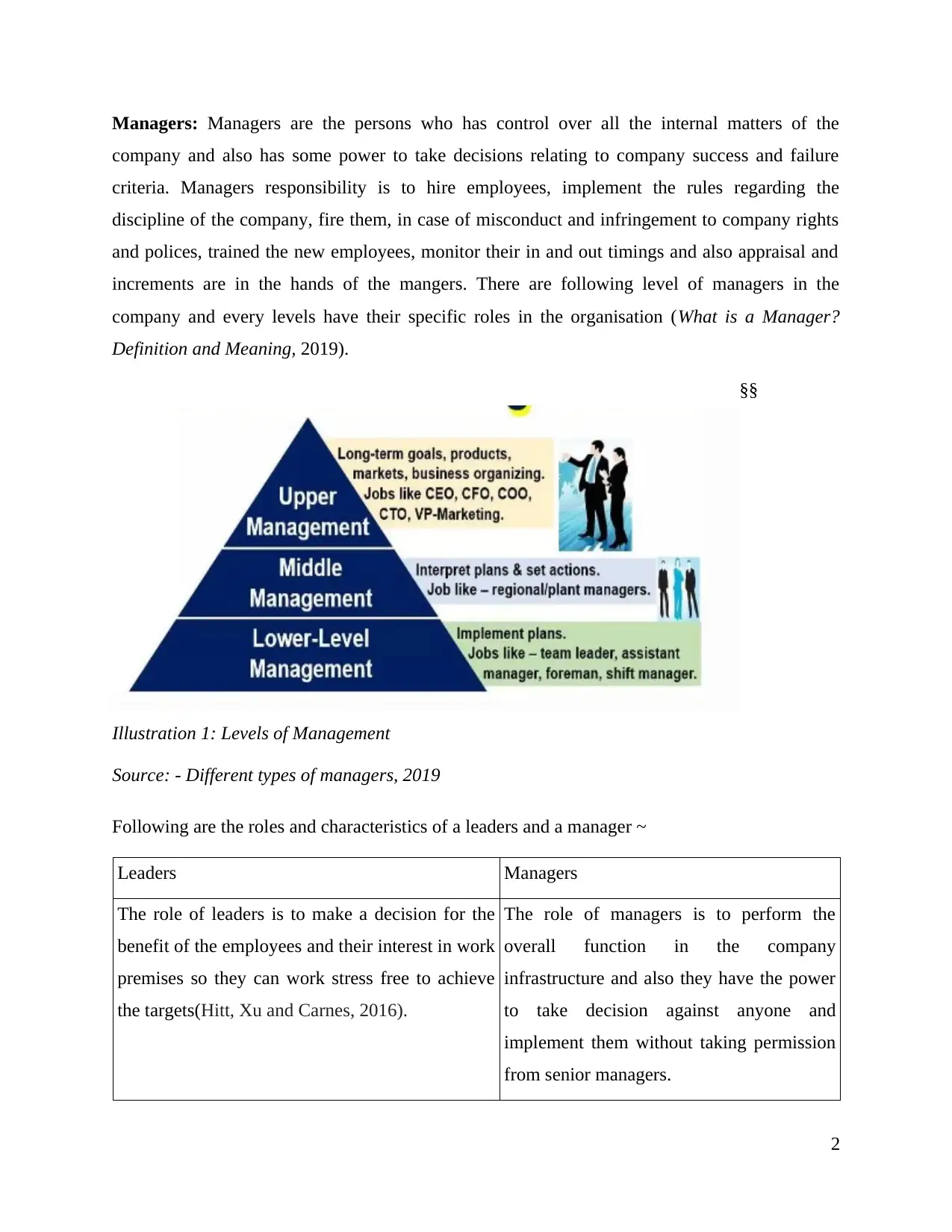
Managers: Managers are the persons who has control over all the internal matters of the
company and also has some power to take decisions relating to company success and failure
criteria. Managers responsibility is to hire employees, implement the rules regarding the
discipline of the company, fire them, in case of misconduct and infringement to company rights
and polices, trained the new employees, monitor their in and out timings and also appraisal and
increments are in the hands of the mangers. There are following level of managers in the
company and every levels have their specific roles in the organisation (What is a Manager?
Definition and Meaning, 2019).
Illustration 1: Levels of Management
Source: - Different types of managers, 2019
§§
Following are the roles and characteristics of a leaders and a manager ~
Leaders Managers
The role of leaders is to make a decision for the
benefit of the employees and their interest in work
premises so they can work stress free to achieve
the targets(Hitt, Xu and Carnes, 2016).
The role of managers is to perform the
overall function in the company
infrastructure and also they have the power
to take decision against anyone and
implement them without taking permission
from senior managers.
2
company and also has some power to take decisions relating to company success and failure
criteria. Managers responsibility is to hire employees, implement the rules regarding the
discipline of the company, fire them, in case of misconduct and infringement to company rights
and polices, trained the new employees, monitor their in and out timings and also appraisal and
increments are in the hands of the mangers. There are following level of managers in the
company and every levels have their specific roles in the organisation (What is a Manager?
Definition and Meaning, 2019).
Illustration 1: Levels of Management
Source: - Different types of managers, 2019
§§
Following are the roles and characteristics of a leaders and a manager ~
Leaders Managers
The role of leaders is to make a decision for the
benefit of the employees and their interest in work
premises so they can work stress free to achieve
the targets(Hitt, Xu and Carnes, 2016).
The role of managers is to perform the
overall function in the company
infrastructure and also they have the power
to take decision against anyone and
implement them without taking permission
from senior managers.
2
Paraphrase This Document
Need a fresh take? Get an instant paraphrase of this document with our AI Paraphraser
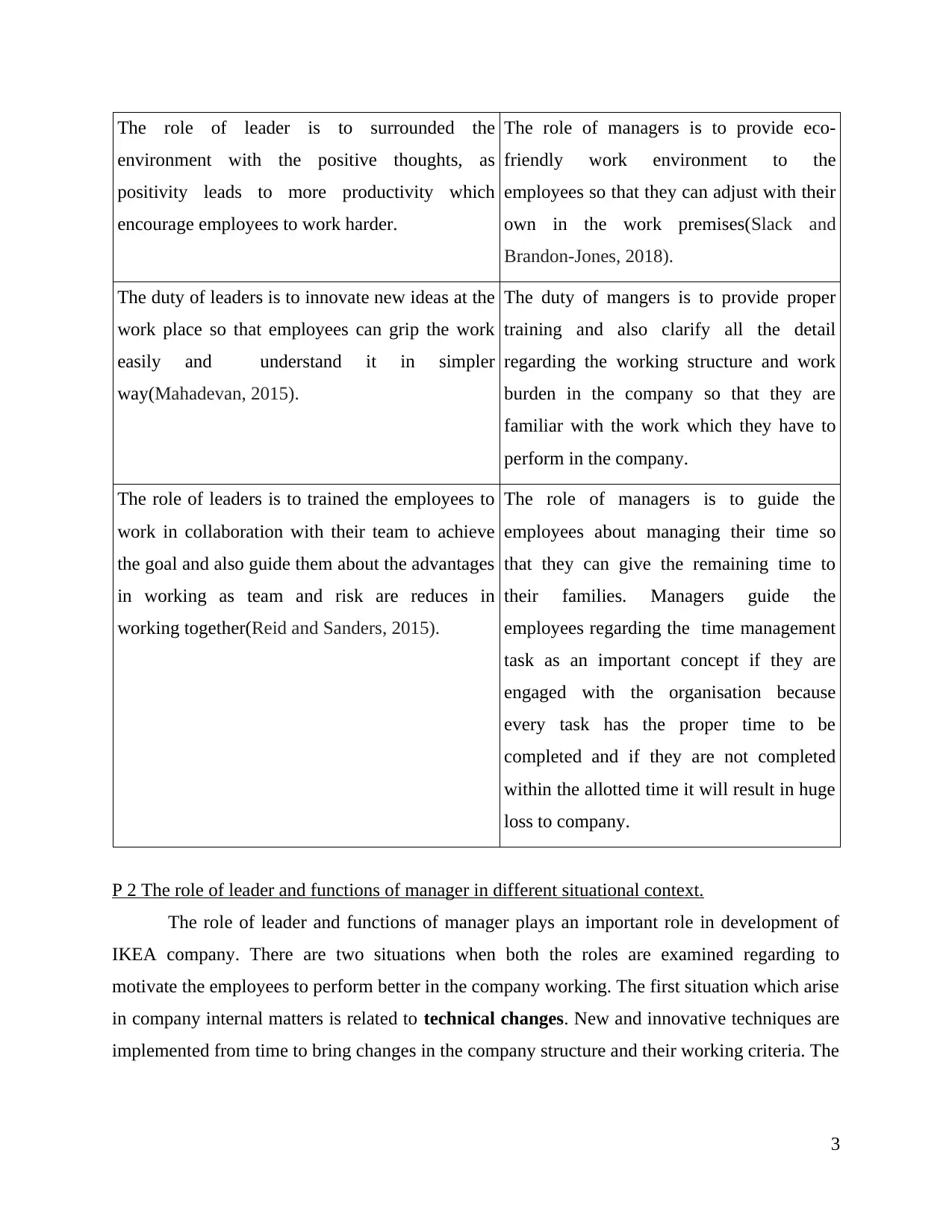
The role of leader is to surrounded the
environment with the positive thoughts, as
positivity leads to more productivity which
encourage employees to work harder.
The role of managers is to provide eco-
friendly work environment to the
employees so that they can adjust with their
own in the work premises(Slack and
Brandon-Jones, 2018).
The duty of leaders is to innovate new ideas at the
work place so that employees can grip the work
easily and understand it in simpler
way(Mahadevan, 2015).
The duty of mangers is to provide proper
training and also clarify all the detail
regarding the working structure and work
burden in the company so that they are
familiar with the work which they have to
perform in the company.
The role of leaders is to trained the employees to
work in collaboration with their team to achieve
the goal and also guide them about the advantages
in working as team and risk are reduces in
working together(Reid and Sanders, 2015).
The role of managers is to guide the
employees about managing their time so
that they can give the remaining time to
their families. Managers guide the
employees regarding the time management
task as an important concept if they are
engaged with the organisation because
every task has the proper time to be
completed and if they are not completed
within the allotted time it will result in huge
loss to company.
P 2 The role of leader and functions of manager in different situational context.
The role of leader and functions of manager plays an important role in development of
IKEA company. There are two situations when both the roles are examined regarding to
motivate the employees to perform better in the company working. The first situation which arise
in company internal matters is related to technical changes. New and innovative techniques are
implemented from time to bring changes in the company structure and their working criteria. The
3
environment with the positive thoughts, as
positivity leads to more productivity which
encourage employees to work harder.
The role of managers is to provide eco-
friendly work environment to the
employees so that they can adjust with their
own in the work premises(Slack and
Brandon-Jones, 2018).
The duty of leaders is to innovate new ideas at the
work place so that employees can grip the work
easily and understand it in simpler
way(Mahadevan, 2015).
The duty of mangers is to provide proper
training and also clarify all the detail
regarding the working structure and work
burden in the company so that they are
familiar with the work which they have to
perform in the company.
The role of leaders is to trained the employees to
work in collaboration with their team to achieve
the goal and also guide them about the advantages
in working as team and risk are reduces in
working together(Reid and Sanders, 2015).
The role of managers is to guide the
employees about managing their time so
that they can give the remaining time to
their families. Managers guide the
employees regarding the time management
task as an important concept if they are
engaged with the organisation because
every task has the proper time to be
completed and if they are not completed
within the allotted time it will result in huge
loss to company.
P 2 The role of leader and functions of manager in different situational context.
The role of leader and functions of manager plays an important role in development of
IKEA company. There are two situations when both the roles are examined regarding to
motivate the employees to perform better in the company working. The first situation which arise
in company internal matters is related to technical changes. New and innovative techniques are
implemented from time to bring changes in the company structure and their working criteria. The
3
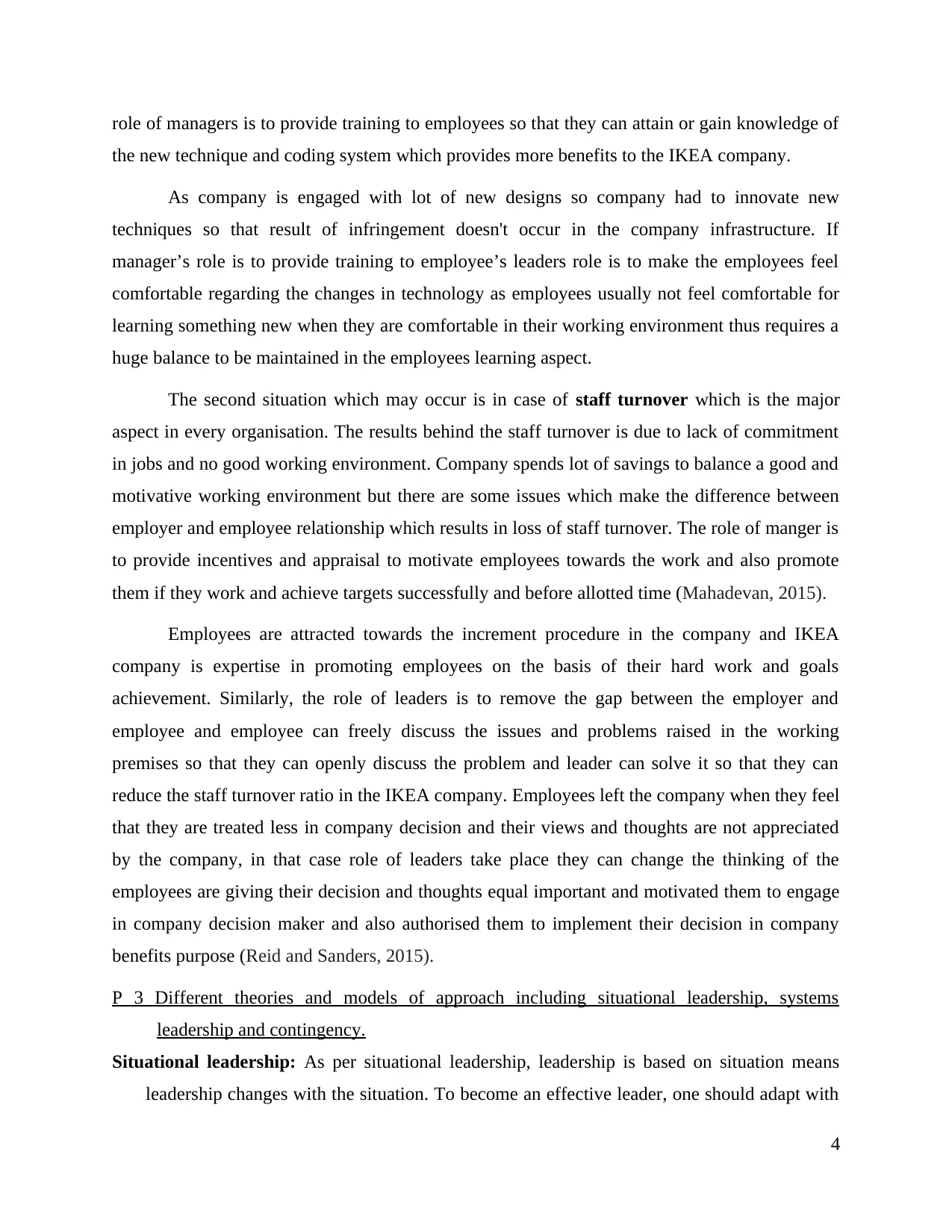
role of managers is to provide training to employees so that they can attain or gain knowledge of
the new technique and coding system which provides more benefits to the IKEA company.
As company is engaged with lot of new designs so company had to innovate new
techniques so that result of infringement doesn't occur in the company infrastructure. If
manager’s role is to provide training to employee’s leaders role is to make the employees feel
comfortable regarding the changes in technology as employees usually not feel comfortable for
learning something new when they are comfortable in their working environment thus requires a
huge balance to be maintained in the employees learning aspect.
The second situation which may occur is in case of staff turnover which is the major
aspect in every organisation. The results behind the staff turnover is due to lack of commitment
in jobs and no good working environment. Company spends lot of savings to balance a good and
motivative working environment but there are some issues which make the difference between
employer and employee relationship which results in loss of staff turnover. The role of manger is
to provide incentives and appraisal to motivate employees towards the work and also promote
them if they work and achieve targets successfully and before allotted time (Mahadevan, 2015).
Employees are attracted towards the increment procedure in the company and IKEA
company is expertise in promoting employees on the basis of their hard work and goals
achievement. Similarly, the role of leaders is to remove the gap between the employer and
employee and employee can freely discuss the issues and problems raised in the working
premises so that they can openly discuss the problem and leader can solve it so that they can
reduce the staff turnover ratio in the IKEA company. Employees left the company when they feel
that they are treated less in company decision and their views and thoughts are not appreciated
by the company, in that case role of leaders take place they can change the thinking of the
employees are giving their decision and thoughts equal important and motivated them to engage
in company decision maker and also authorised them to implement their decision in company
benefits purpose (Reid and Sanders, 2015).
P 3 Different theories and models of approach including situational leadership, systems
leadership and contingency.
Situational leadership: As per situational leadership, leadership is based on situation means
leadership changes with the situation. To become an effective leader, one should adapt with
4
the new technique and coding system which provides more benefits to the IKEA company.
As company is engaged with lot of new designs so company had to innovate new
techniques so that result of infringement doesn't occur in the company infrastructure. If
manager’s role is to provide training to employee’s leaders role is to make the employees feel
comfortable regarding the changes in technology as employees usually not feel comfortable for
learning something new when they are comfortable in their working environment thus requires a
huge balance to be maintained in the employees learning aspect.
The second situation which may occur is in case of staff turnover which is the major
aspect in every organisation. The results behind the staff turnover is due to lack of commitment
in jobs and no good working environment. Company spends lot of savings to balance a good and
motivative working environment but there are some issues which make the difference between
employer and employee relationship which results in loss of staff turnover. The role of manger is
to provide incentives and appraisal to motivate employees towards the work and also promote
them if they work and achieve targets successfully and before allotted time (Mahadevan, 2015).
Employees are attracted towards the increment procedure in the company and IKEA
company is expertise in promoting employees on the basis of their hard work and goals
achievement. Similarly, the role of leaders is to remove the gap between the employer and
employee and employee can freely discuss the issues and problems raised in the working
premises so that they can openly discuss the problem and leader can solve it so that they can
reduce the staff turnover ratio in the IKEA company. Employees left the company when they feel
that they are treated less in company decision and their views and thoughts are not appreciated
by the company, in that case role of leaders take place they can change the thinking of the
employees are giving their decision and thoughts equal important and motivated them to engage
in company decision maker and also authorised them to implement their decision in company
benefits purpose (Reid and Sanders, 2015).
P 3 Different theories and models of approach including situational leadership, systems
leadership and contingency.
Situational leadership: As per situational leadership, leadership is based on situation means
leadership changes with the situation. To become an effective leader, one should adapt with
4
⊘ This is a preview!⊘
Do you want full access?
Subscribe today to unlock all pages.

Trusted by 1+ million students worldwide
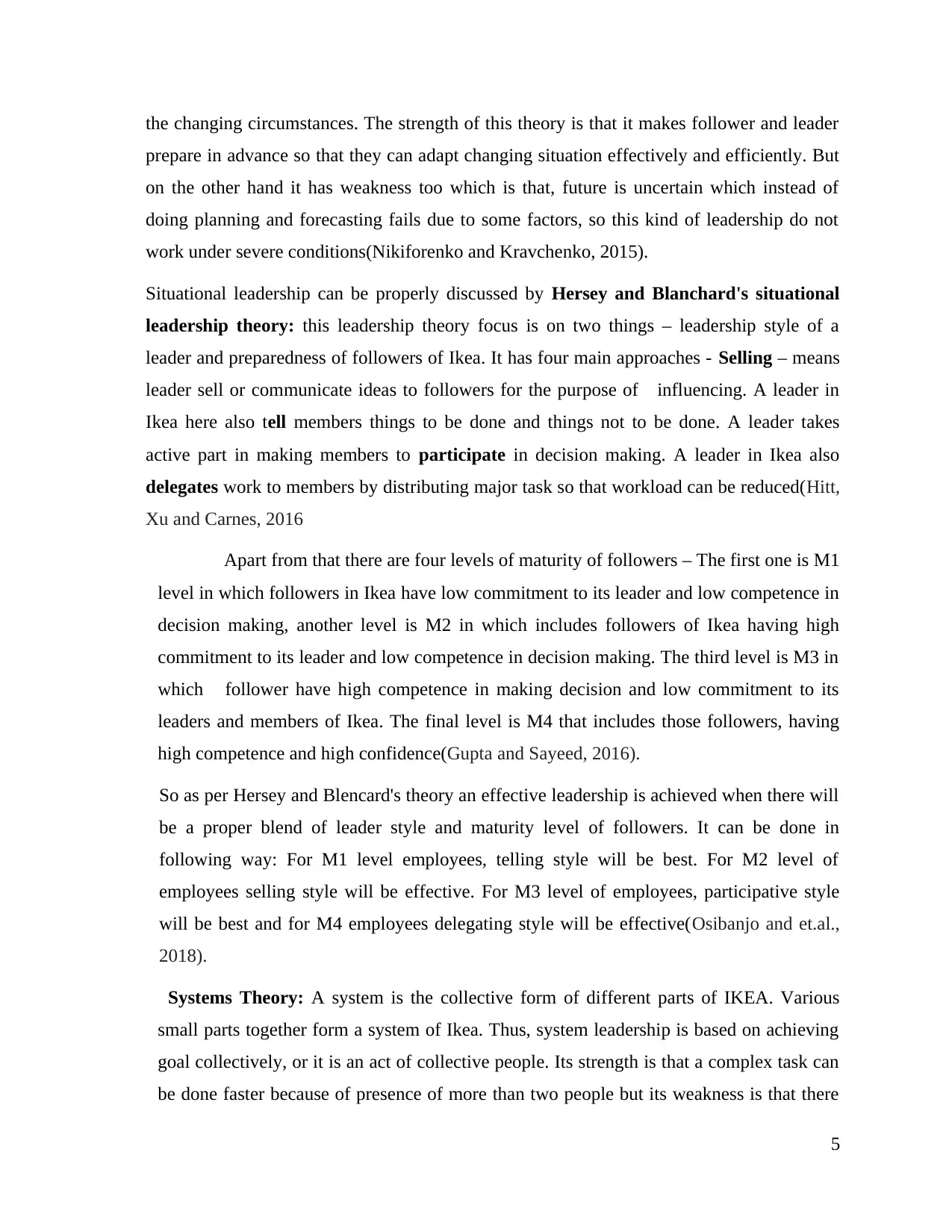
the changing circumstances. The strength of this theory is that it makes follower and leader
prepare in advance so that they can adapt changing situation effectively and efficiently. But
on the other hand it has weakness too which is that, future is uncertain which instead of
doing planning and forecasting fails due to some factors, so this kind of leadership do not
work under severe conditions(Nikiforenko and Kravchenko, 2015).
Situational leadership can be properly discussed by Hersey and Blanchard's situational
leadership theory: this leadership theory focus is on two things – leadership style of a
leader and preparedness of followers of Ikea. It has four main approaches - Selling – means
leader sell or communicate ideas to followers for the purpose of influencing. A leader in
Ikea here also tell members things to be done and things not to be done. A leader takes
active part in making members to participate in decision making. A leader in Ikea also
delegates work to members by distributing major task so that workload can be reduced(Hitt,
Xu and Carnes, 2016
Apart from that there are four levels of maturity of followers – The first one is M1
level in which followers in Ikea have low commitment to its leader and low competence in
decision making, another level is M2 in which includes followers of Ikea having high
commitment to its leader and low competence in decision making. The third level is M3 in
which follower have high competence in making decision and low commitment to its
leaders and members of Ikea. The final level is M4 that includes those followers, having
high competence and high confidence(Gupta and Sayeed, 2016).
So as per Hersey and Blencard's theory an effective leadership is achieved when there will
be a proper blend of leader style and maturity level of followers. It can be done in
following way: For M1 level employees, telling style will be best. For M2 level of
employees selling style will be effective. For M3 level of employees, participative style
will be best and for M4 employees delegating style will be effective(Osibanjo and et.al.,
2018).
Systems Theory: A system is the collective form of different parts of IKEA. Various
small parts together form a system of Ikea. Thus, system leadership is based on achieving
goal collectively, or it is an act of collective people. Its strength is that a complex task can
be done faster because of presence of more than two people but its weakness is that there
5
prepare in advance so that they can adapt changing situation effectively and efficiently. But
on the other hand it has weakness too which is that, future is uncertain which instead of
doing planning and forecasting fails due to some factors, so this kind of leadership do not
work under severe conditions(Nikiforenko and Kravchenko, 2015).
Situational leadership can be properly discussed by Hersey and Blanchard's situational
leadership theory: this leadership theory focus is on two things – leadership style of a
leader and preparedness of followers of Ikea. It has four main approaches - Selling – means
leader sell or communicate ideas to followers for the purpose of influencing. A leader in
Ikea here also tell members things to be done and things not to be done. A leader takes
active part in making members to participate in decision making. A leader in Ikea also
delegates work to members by distributing major task so that workload can be reduced(Hitt,
Xu and Carnes, 2016
Apart from that there are four levels of maturity of followers – The first one is M1
level in which followers in Ikea have low commitment to its leader and low competence in
decision making, another level is M2 in which includes followers of Ikea having high
commitment to its leader and low competence in decision making. The third level is M3 in
which follower have high competence in making decision and low commitment to its
leaders and members of Ikea. The final level is M4 that includes those followers, having
high competence and high confidence(Gupta and Sayeed, 2016).
So as per Hersey and Blencard's theory an effective leadership is achieved when there will
be a proper blend of leader style and maturity level of followers. It can be done in
following way: For M1 level employees, telling style will be best. For M2 level of
employees selling style will be effective. For M3 level of employees, participative style
will be best and for M4 employees delegating style will be effective(Osibanjo and et.al.,
2018).
Systems Theory: A system is the collective form of different parts of IKEA. Various
small parts together form a system of Ikea. Thus, system leadership is based on achieving
goal collectively, or it is an act of collective people. Its strength is that a complex task can
be done faster because of presence of more than two people but its weakness is that there
5
Paraphrase This Document
Need a fresh take? Get an instant paraphrase of this document with our AI Paraphraser
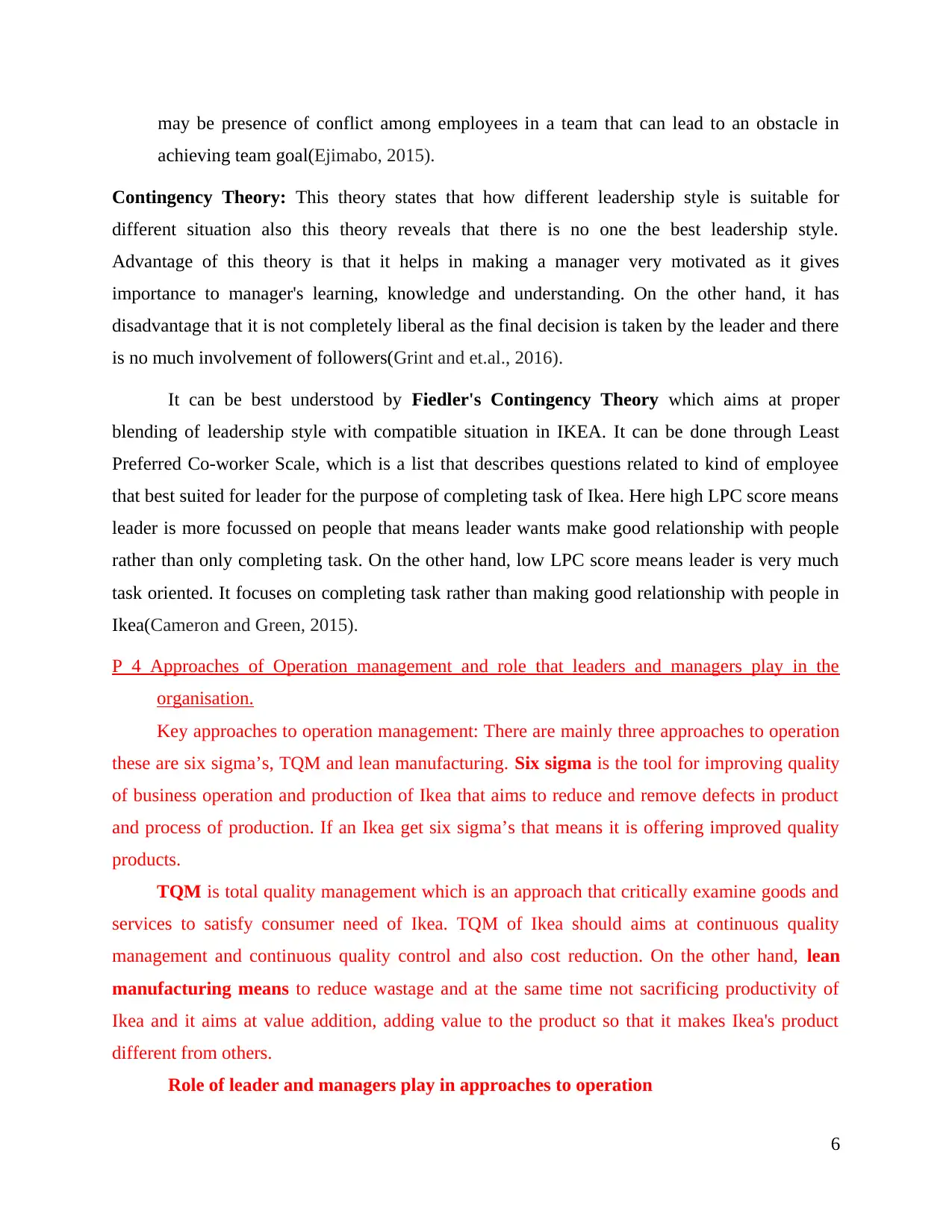
may be presence of conflict among employees in a team that can lead to an obstacle in
achieving team goal(Ejimabo, 2015).
Contingency Theory: This theory states that how different leadership style is suitable for
different situation also this theory reveals that there is no one the best leadership style.
Advantage of this theory is that it helps in making a manager very motivated as it gives
importance to manager's learning, knowledge and understanding. On the other hand, it has
disadvantage that it is not completely liberal as the final decision is taken by the leader and there
is no much involvement of followers(Grint and et.al., 2016).
It can be best understood by Fiedler's Contingency Theory which aims at proper
blending of leadership style with compatible situation in IKEA. It can be done through Least
Preferred Co-worker Scale, which is a list that describes questions related to kind of employee
that best suited for leader for the purpose of completing task of Ikea. Here high LPC score means
leader is more focussed on people that means leader wants make good relationship with people
rather than only completing task. On the other hand, low LPC score means leader is very much
task oriented. It focuses on completing task rather than making good relationship with people in
Ikea(Cameron and Green, 2015).
P 4 Approaches of Operation management and role that leaders and managers play in the
organisation.
Key approaches to operation management: There are mainly three approaches to operation
these are six sigma’s, TQM and lean manufacturing. Six sigma is the tool for improving quality
of business operation and production of Ikea that aims to reduce and remove defects in product
and process of production. If an Ikea get six sigma’s that means it is offering improved quality
products.
TQM is total quality management which is an approach that critically examine goods and
services to satisfy consumer need of Ikea. TQM of Ikea should aims at continuous quality
management and continuous quality control and also cost reduction. On the other hand, lean
manufacturing means to reduce wastage and at the same time not sacrificing productivity of
Ikea and it aims at value addition, adding value to the product so that it makes Ikea's product
different from others.
Role of leader and managers play in approaches to operation
6
achieving team goal(Ejimabo, 2015).
Contingency Theory: This theory states that how different leadership style is suitable for
different situation also this theory reveals that there is no one the best leadership style.
Advantage of this theory is that it helps in making a manager very motivated as it gives
importance to manager's learning, knowledge and understanding. On the other hand, it has
disadvantage that it is not completely liberal as the final decision is taken by the leader and there
is no much involvement of followers(Grint and et.al., 2016).
It can be best understood by Fiedler's Contingency Theory which aims at proper
blending of leadership style with compatible situation in IKEA. It can be done through Least
Preferred Co-worker Scale, which is a list that describes questions related to kind of employee
that best suited for leader for the purpose of completing task of Ikea. Here high LPC score means
leader is more focussed on people that means leader wants make good relationship with people
rather than only completing task. On the other hand, low LPC score means leader is very much
task oriented. It focuses on completing task rather than making good relationship with people in
Ikea(Cameron and Green, 2015).
P 4 Approaches of Operation management and role that leaders and managers play in the
organisation.
Key approaches to operation management: There are mainly three approaches to operation
these are six sigma’s, TQM and lean manufacturing. Six sigma is the tool for improving quality
of business operation and production of Ikea that aims to reduce and remove defects in product
and process of production. If an Ikea get six sigma’s that means it is offering improved quality
products.
TQM is total quality management which is an approach that critically examine goods and
services to satisfy consumer need of Ikea. TQM of Ikea should aims at continuous quality
management and continuous quality control and also cost reduction. On the other hand, lean
manufacturing means to reduce wastage and at the same time not sacrificing productivity of
Ikea and it aims at value addition, adding value to the product so that it makes Ikea's product
different from others.
Role of leader and managers play in approaches to operation
6
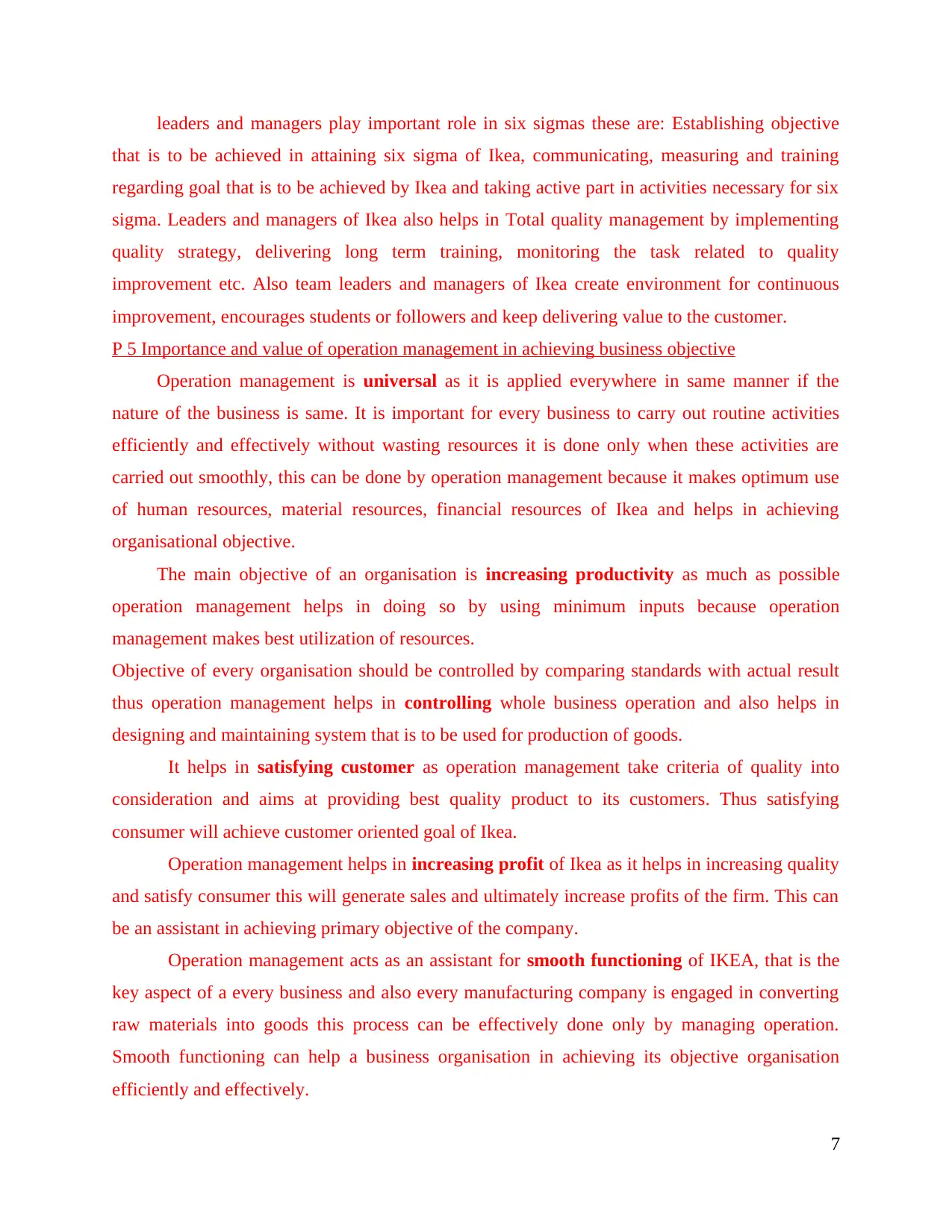
leaders and managers play important role in six sigmas these are: Establishing objective
that is to be achieved in attaining six sigma of Ikea, communicating, measuring and training
regarding goal that is to be achieved by Ikea and taking active part in activities necessary for six
sigma. Leaders and managers of Ikea also helps in Total quality management by implementing
quality strategy, delivering long term training, monitoring the task related to quality
improvement etc. Also team leaders and managers of Ikea create environment for continuous
improvement, encourages students or followers and keep delivering value to the customer.
P 5 Importance and value of operation management in achieving business objective
Operation management is universal as it is applied everywhere in same manner if the
nature of the business is same. It is important for every business to carry out routine activities
efficiently and effectively without wasting resources it is done only when these activities are
carried out smoothly, this can be done by operation management because it makes optimum use
of human resources, material resources, financial resources of Ikea and helps in achieving
organisational objective.
The main objective of an organisation is increasing productivity as much as possible
operation management helps in doing so by using minimum inputs because operation
management makes best utilization of resources.
Objective of every organisation should be controlled by comparing standards with actual result
thus operation management helps in controlling whole business operation and also helps in
designing and maintaining system that is to be used for production of goods.
It helps in satisfying customer as operation management take criteria of quality into
consideration and aims at providing best quality product to its customers. Thus satisfying
consumer will achieve customer oriented goal of Ikea.
Operation management helps in increasing profit of Ikea as it helps in increasing quality
and satisfy consumer this will generate sales and ultimately increase profits of the firm. This can
be an assistant in achieving primary objective of the company.
Operation management acts as an assistant for smooth functioning of IKEA, that is the
key aspect of a every business and also every manufacturing company is engaged in converting
raw materials into goods this process can be effectively done only by managing operation.
Smooth functioning can help a business organisation in achieving its objective organisation
efficiently and effectively.
7
that is to be achieved in attaining six sigma of Ikea, communicating, measuring and training
regarding goal that is to be achieved by Ikea and taking active part in activities necessary for six
sigma. Leaders and managers of Ikea also helps in Total quality management by implementing
quality strategy, delivering long term training, monitoring the task related to quality
improvement etc. Also team leaders and managers of Ikea create environment for continuous
improvement, encourages students or followers and keep delivering value to the customer.
P 5 Importance and value of operation management in achieving business objective
Operation management is universal as it is applied everywhere in same manner if the
nature of the business is same. It is important for every business to carry out routine activities
efficiently and effectively without wasting resources it is done only when these activities are
carried out smoothly, this can be done by operation management because it makes optimum use
of human resources, material resources, financial resources of Ikea and helps in achieving
organisational objective.
The main objective of an organisation is increasing productivity as much as possible
operation management helps in doing so by using minimum inputs because operation
management makes best utilization of resources.
Objective of every organisation should be controlled by comparing standards with actual result
thus operation management helps in controlling whole business operation and also helps in
designing and maintaining system that is to be used for production of goods.
It helps in satisfying customer as operation management take criteria of quality into
consideration and aims at providing best quality product to its customers. Thus satisfying
consumer will achieve customer oriented goal of Ikea.
Operation management helps in increasing profit of Ikea as it helps in increasing quality
and satisfy consumer this will generate sales and ultimately increase profits of the firm. This can
be an assistant in achieving primary objective of the company.
Operation management acts as an assistant for smooth functioning of IKEA, that is the
key aspect of a every business and also every manufacturing company is engaged in converting
raw materials into goods this process can be effectively done only by managing operation.
Smooth functioning can help a business organisation in achieving its objective organisation
efficiently and effectively.
7
⊘ This is a preview!⊘
Do you want full access?
Subscribe today to unlock all pages.

Trusted by 1+ million students worldwide
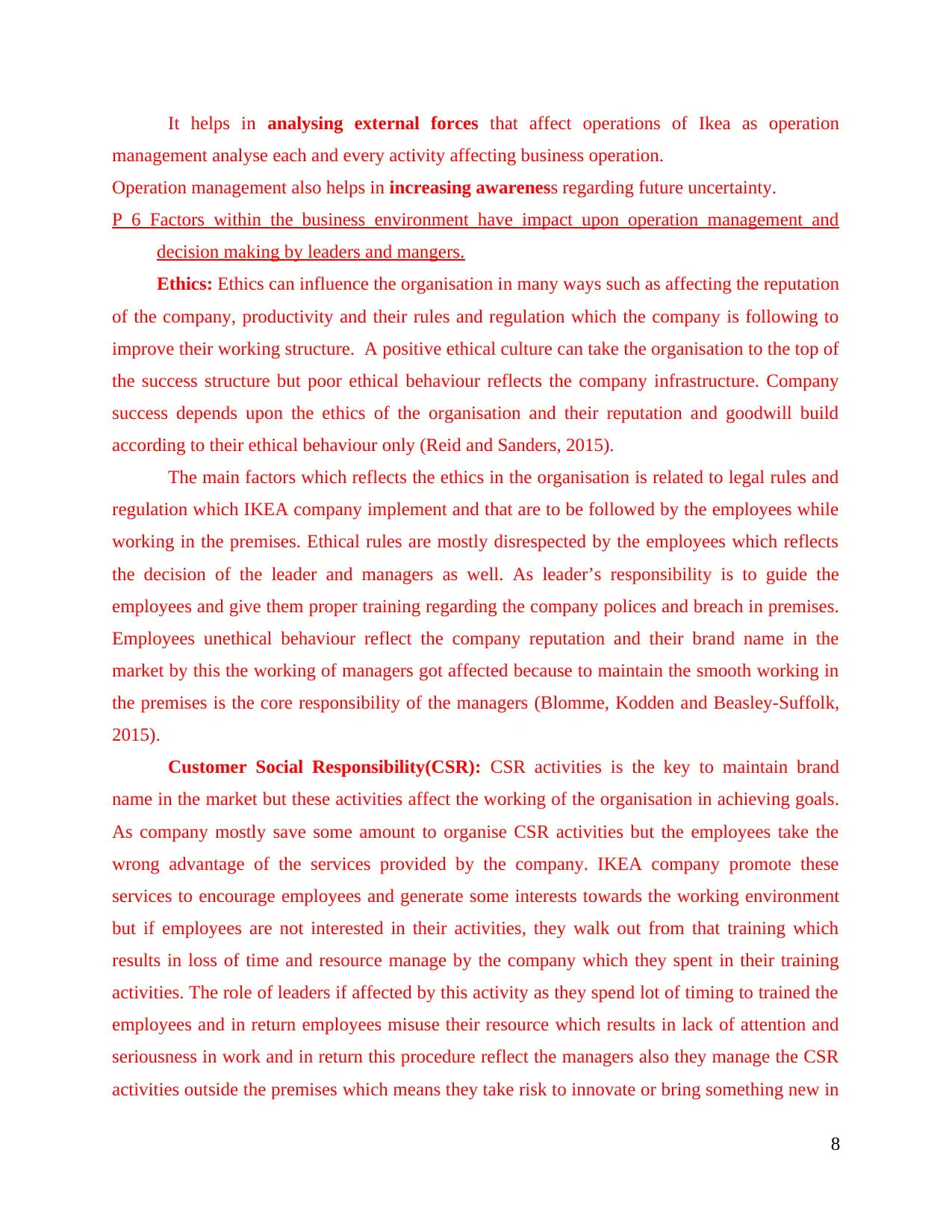
It helps in analysing external forces that affect operations of Ikea as operation
management analyse each and every activity affecting business operation.
Operation management also helps in increasing awareness regarding future uncertainty.
P 6 Factors within the business environment have impact upon operation management and
decision making by leaders and mangers.
Ethics: Ethics can influence the organisation in many ways such as affecting the reputation
of the company, productivity and their rules and regulation which the company is following to
improve their working structure. A positive ethical culture can take the organisation to the top of
the success structure but poor ethical behaviour reflects the company infrastructure. Company
success depends upon the ethics of the organisation and their reputation and goodwill build
according to their ethical behaviour only (Reid and Sanders, 2015).
The main factors which reflects the ethics in the organisation is related to legal rules and
regulation which IKEA company implement and that are to be followed by the employees while
working in the premises. Ethical rules are mostly disrespected by the employees which reflects
the decision of the leader and managers as well. As leader’s responsibility is to guide the
employees and give them proper training regarding the company polices and breach in premises.
Employees unethical behaviour reflect the company reputation and their brand name in the
market by this the working of managers got affected because to maintain the smooth working in
the premises is the core responsibility of the managers (Blomme, Kodden and Beasley-Suffolk,
2015).
Customer Social Responsibility(CSR): CSR activities is the key to maintain brand
name in the market but these activities affect the working of the organisation in achieving goals.
As company mostly save some amount to organise CSR activities but the employees take the
wrong advantage of the services provided by the company. IKEA company promote these
services to encourage employees and generate some interests towards the working environment
but if employees are not interested in their activities, they walk out from that training which
results in loss of time and resource manage by the company which they spent in their training
activities. The role of leaders if affected by this activity as they spend lot of timing to trained the
employees and in return employees misuse their resource which results in lack of attention and
seriousness in work and in return this procedure reflect the managers also they manage the CSR
activities outside the premises which means they take risk to innovate or bring something new in
8
management analyse each and every activity affecting business operation.
Operation management also helps in increasing awareness regarding future uncertainty.
P 6 Factors within the business environment have impact upon operation management and
decision making by leaders and mangers.
Ethics: Ethics can influence the organisation in many ways such as affecting the reputation
of the company, productivity and their rules and regulation which the company is following to
improve their working structure. A positive ethical culture can take the organisation to the top of
the success structure but poor ethical behaviour reflects the company infrastructure. Company
success depends upon the ethics of the organisation and their reputation and goodwill build
according to their ethical behaviour only (Reid and Sanders, 2015).
The main factors which reflects the ethics in the organisation is related to legal rules and
regulation which IKEA company implement and that are to be followed by the employees while
working in the premises. Ethical rules are mostly disrespected by the employees which reflects
the decision of the leader and managers as well. As leader’s responsibility is to guide the
employees and give them proper training regarding the company polices and breach in premises.
Employees unethical behaviour reflect the company reputation and their brand name in the
market by this the working of managers got affected because to maintain the smooth working in
the premises is the core responsibility of the managers (Blomme, Kodden and Beasley-Suffolk,
2015).
Customer Social Responsibility(CSR): CSR activities is the key to maintain brand
name in the market but these activities affect the working of the organisation in achieving goals.
As company mostly save some amount to organise CSR activities but the employees take the
wrong advantage of the services provided by the company. IKEA company promote these
services to encourage employees and generate some interests towards the working environment
but if employees are not interested in their activities, they walk out from that training which
results in loss of time and resource manage by the company which they spent in their training
activities. The role of leaders if affected by this activity as they spend lot of timing to trained the
employees and in return employees misuse their resource which results in lack of attention and
seriousness in work and in return this procedure reflect the managers also they manage the CSR
activities outside the premises which means they take risk to innovate or bring something new in
8
Paraphrase This Document
Need a fresh take? Get an instant paraphrase of this document with our AI Paraphraser
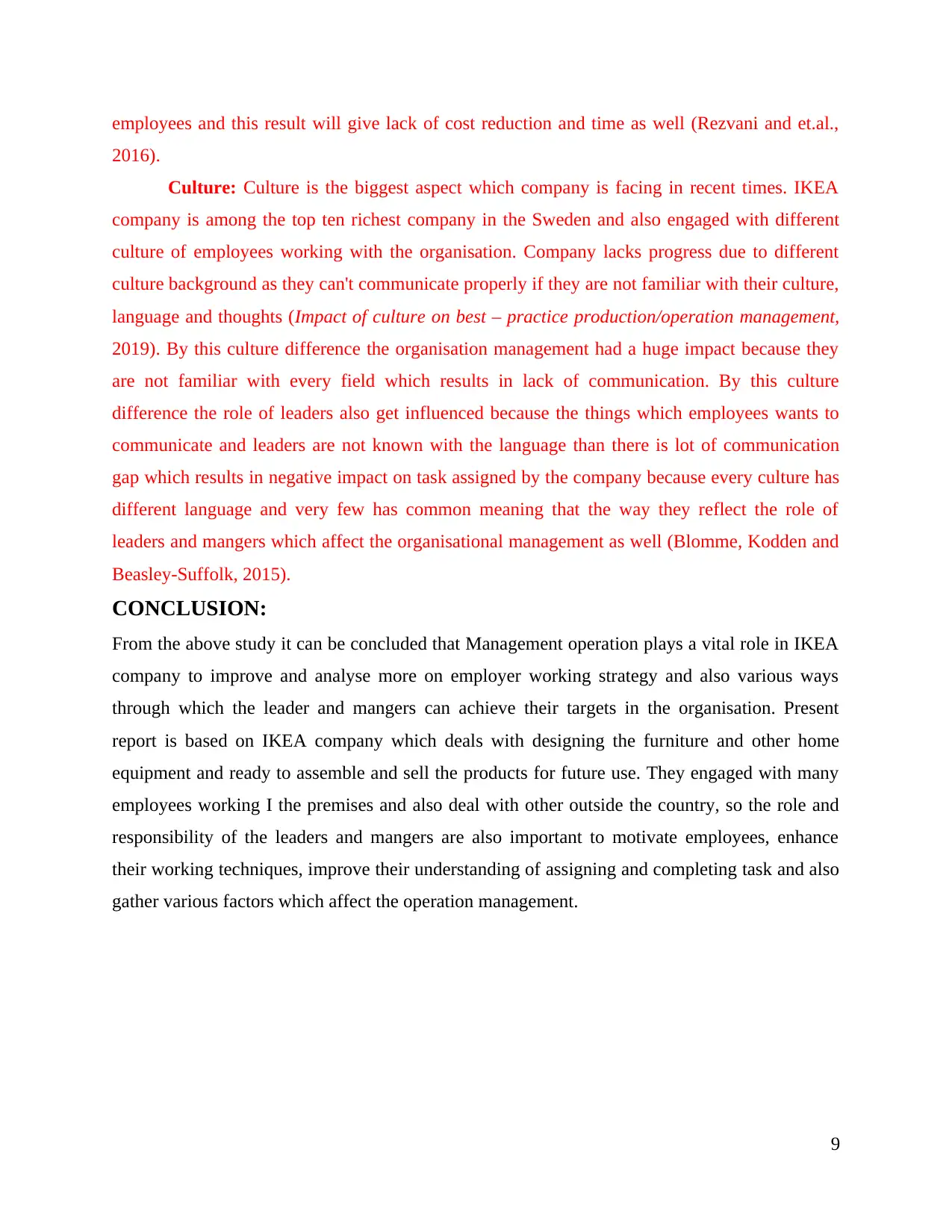
employees and this result will give lack of cost reduction and time as well (Rezvani and et.al.,
2016).
Culture: Culture is the biggest aspect which company is facing in recent times. IKEA
company is among the top ten richest company in the Sweden and also engaged with different
culture of employees working with the organisation. Company lacks progress due to different
culture background as they can't communicate properly if they are not familiar with their culture,
language and thoughts (Impact of culture on best – practice production/operation management,
2019). By this culture difference the organisation management had a huge impact because they
are not familiar with every field which results in lack of communication. By this culture
difference the role of leaders also get influenced because the things which employees wants to
communicate and leaders are not known with the language than there is lot of communication
gap which results in negative impact on task assigned by the company because every culture has
different language and very few has common meaning that the way they reflect the role of
leaders and mangers which affect the organisational management as well (Blomme, Kodden and
Beasley-Suffolk, 2015).
CONCLUSION:
From the above study it can be concluded that Management operation plays a vital role in IKEA
company to improve and analyse more on employer working strategy and also various ways
through which the leader and mangers can achieve their targets in the organisation. Present
report is based on IKEA company which deals with designing the furniture and other home
equipment and ready to assemble and sell the products for future use. They engaged with many
employees working I the premises and also deal with other outside the country, so the role and
responsibility of the leaders and mangers are also important to motivate employees, enhance
their working techniques, improve their understanding of assigning and completing task and also
gather various factors which affect the operation management.
9
2016).
Culture: Culture is the biggest aspect which company is facing in recent times. IKEA
company is among the top ten richest company in the Sweden and also engaged with different
culture of employees working with the organisation. Company lacks progress due to different
culture background as they can't communicate properly if they are not familiar with their culture,
language and thoughts (Impact of culture on best – practice production/operation management,
2019). By this culture difference the organisation management had a huge impact because they
are not familiar with every field which results in lack of communication. By this culture
difference the role of leaders also get influenced because the things which employees wants to
communicate and leaders are not known with the language than there is lot of communication
gap which results in negative impact on task assigned by the company because every culture has
different language and very few has common meaning that the way they reflect the role of
leaders and mangers which affect the organisational management as well (Blomme, Kodden and
Beasley-Suffolk, 2015).
CONCLUSION:
From the above study it can be concluded that Management operation plays a vital role in IKEA
company to improve and analyse more on employer working strategy and also various ways
through which the leader and mangers can achieve their targets in the organisation. Present
report is based on IKEA company which deals with designing the furniture and other home
equipment and ready to assemble and sell the products for future use. They engaged with many
employees working I the premises and also deal with other outside the country, so the role and
responsibility of the leaders and mangers are also important to motivate employees, enhance
their working techniques, improve their understanding of assigning and completing task and also
gather various factors which affect the operation management.
9
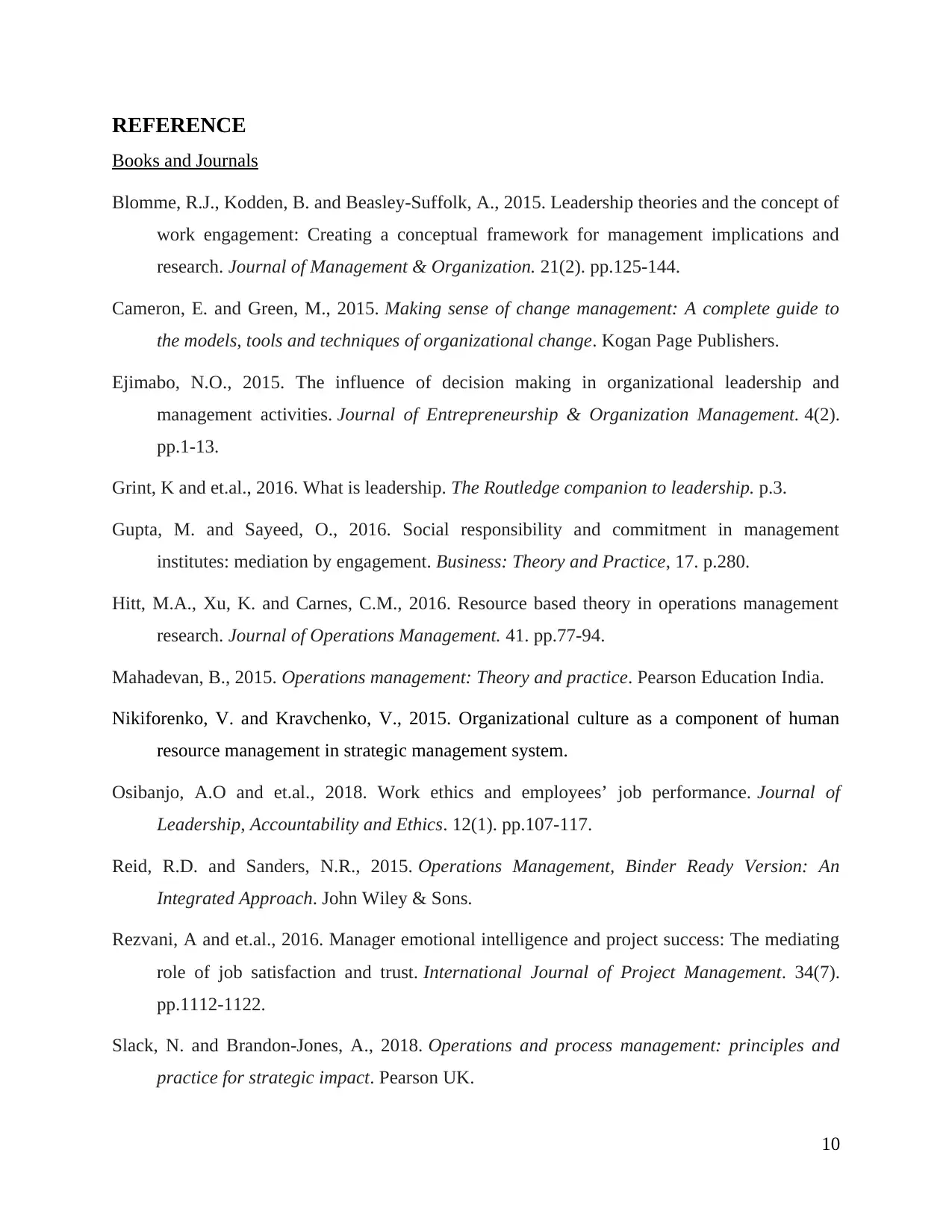
REFERENCE
Books and Journals
Blomme, R.J., Kodden, B. and Beasley-Suffolk, A., 2015. Leadership theories and the concept of
work engagement: Creating a conceptual framework for management implications and
research. Journal of Management & Organization. 21(2). pp.125-144.
Cameron, E. and Green, M., 2015. Making sense of change management: A complete guide to
the models, tools and techniques of organizational change. Kogan Page Publishers.
Ejimabo, N.O., 2015. The influence of decision making in organizational leadership and
management activities. Journal of Entrepreneurship & Organization Management. 4(2).
pp.1-13.
Grint, K and et.al., 2016. What is leadership. The Routledge companion to leadership. p.3.
Gupta, M. and Sayeed, O., 2016. Social responsibility and commitment in management
institutes: mediation by engagement. Business: Theory and Practice, 17. p.280.
Hitt, M.A., Xu, K. and Carnes, C.M., 2016. Resource based theory in operations management
research. Journal of Operations Management. 41. pp.77-94.
Mahadevan, B., 2015. Operations management: Theory and practice. Pearson Education India.
Nikiforenko, V. and Kravchenko, V., 2015. Organizational culture as a component of human
resource management in strategic management system.
Osibanjo, A.O and et.al., 2018. Work ethics and employees’ job performance. Journal of
Leadership, Accountability and Ethics. 12(1). pp.107-117.
Reid, R.D. and Sanders, N.R., 2015. Operations Management, Binder Ready Version: An
Integrated Approach. John Wiley & Sons.
Rezvani, A and et.al., 2016. Manager emotional intelligence and project success: The mediating
role of job satisfaction and trust. International Journal of Project Management. 34(7).
pp.1112-1122.
Slack, N. and Brandon-Jones, A., 2018. Operations and process management: principles and
practice for strategic impact. Pearson UK.
10
Books and Journals
Blomme, R.J., Kodden, B. and Beasley-Suffolk, A., 2015. Leadership theories and the concept of
work engagement: Creating a conceptual framework for management implications and
research. Journal of Management & Organization. 21(2). pp.125-144.
Cameron, E. and Green, M., 2015. Making sense of change management: A complete guide to
the models, tools and techniques of organizational change. Kogan Page Publishers.
Ejimabo, N.O., 2015. The influence of decision making in organizational leadership and
management activities. Journal of Entrepreneurship & Organization Management. 4(2).
pp.1-13.
Grint, K and et.al., 2016. What is leadership. The Routledge companion to leadership. p.3.
Gupta, M. and Sayeed, O., 2016. Social responsibility and commitment in management
institutes: mediation by engagement. Business: Theory and Practice, 17. p.280.
Hitt, M.A., Xu, K. and Carnes, C.M., 2016. Resource based theory in operations management
research. Journal of Operations Management. 41. pp.77-94.
Mahadevan, B., 2015. Operations management: Theory and practice. Pearson Education India.
Nikiforenko, V. and Kravchenko, V., 2015. Organizational culture as a component of human
resource management in strategic management system.
Osibanjo, A.O and et.al., 2018. Work ethics and employees’ job performance. Journal of
Leadership, Accountability and Ethics. 12(1). pp.107-117.
Reid, R.D. and Sanders, N.R., 2015. Operations Management, Binder Ready Version: An
Integrated Approach. John Wiley & Sons.
Rezvani, A and et.al., 2016. Manager emotional intelligence and project success: The mediating
role of job satisfaction and trust. International Journal of Project Management. 34(7).
pp.1112-1122.
Slack, N. and Brandon-Jones, A., 2018. Operations and process management: principles and
practice for strategic impact. Pearson UK.
10
⊘ This is a preview!⊘
Do you want full access?
Subscribe today to unlock all pages.

Trusted by 1+ million students worldwide
1 out of 13
Related Documents
Your All-in-One AI-Powered Toolkit for Academic Success.
+13062052269
info@desklib.com
Available 24*7 on WhatsApp / Email
![[object Object]](/_next/static/media/star-bottom.7253800d.svg)
Unlock your academic potential
Copyright © 2020–2025 A2Z Services. All Rights Reserved. Developed and managed by ZUCOL.





